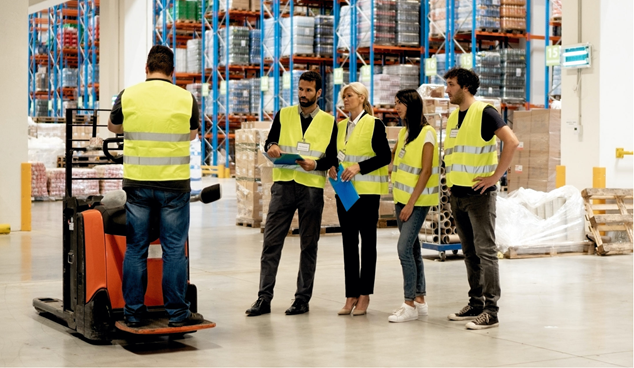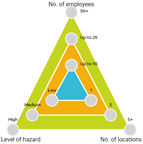Competent Person, Legal Responsibilities and Important Considerations
The Board of Directors or Partners of a business, have a statutory duty (under The Management of Health and Safety at Work Regulations 1999) to appoint a Competent Person.
Typically this is achieved with an in-house Health and Safety Person or by using an external Competent Person. In this Insight we look at what is a Competent Person and how can a business best address this requirement.
What is a Competent Person?
A Competent Person has the skills, knowledge and experience to be able to recognise hazards in the business and help put sensible controls in place to protect workers and others from harm.
The Competent Person should have experience in your sector to be familiar with the hazards and risks and how to treat them.
Is a Competent Person ultimately responsible for Safety?
No, this will fall to the Director or Partner named in your Health and Safety policy, but in fact Directors, Managers, Supervisors and Employees all have a statutory responsibility for safety in the workplace.
What Qualifications does a Competent Person need?
There are no set standards of qualification or accreditation for a Competent Person. The level of skills, knowledge and experience will depend on the nature of the working environment; an office environment will require lower levels than a heavy engineering plant.
In practical terms, NEBOSH Qualifications and IOSH Accreditations are regarded as benchmarks for levels of competency.
Should you have an in-house or use an external Competent Person?
This is a decision for you to take and should be based on a number of factors including;
- the size of the business,
- the number of employees, and
- the nature of the activities and the hazards from these activities that take place.
|
|
There will also be a cost consideration.
The greater the hazards in the business process the more important it will be to manage the risks on a day-to-day basis with the appropriate technical skill and competency on site. A remote Competent Person may not be suitable.
Similarly, the larger the business, the more employees, the more locations, the more safety activity there is to deal with, coordinate and manage. A business is a dynamic environment and there is a strong body of opinion amongst Health and Safety professionals that to adequately protect the business and its employees, the Competent Person should be actively involved in the business day-to-day, so it can be hard for an external person to achieve this.
The Competent Person also has to have authority to act and that too can be challenging for an external Competent Person.
An in-house Competent Person will have a higher perceived cost compared to an external Competent Person but there are other important operational considerations, all of which have a cost impact if you use an external competency service, which we explore below.
Whilst the Competent Person can be seen as a compliance requirement, it can be better to think of them as managing the business risk from accidents or incidents in the workplace. The impact and cost of these can be substantial and can ultimately lead to the failure of the business.
For information on current Fines that can be awarded for Health and Safety, Corporate Manslaughter and Food Safety Offences (these are now based on the Size of the organisation, the degree of harm and the culpability of the organisation) click here.
Why operational considerations are there when weighing up an in-house Competent Person vs an external Competent Person?
There are practicalities that need to be considered;
- How does the Competent Person know when there are issues that need to be addressed when Health and Safety Procedures aren’t being followed?
When the Competent Person is in-house, it's much easier to observe working activity and when there are shortfalls in safety arrangements.
A good example of this might be the use of Personal Protective Equipment(PPE), such as ear protection in an area with high noise levels. Human behaviour has a significant bearing on workplace safety and not witnessing workplace behaviour reduces the Competent Person’s ability to support the business.
An in-house Competent Person will have the opportunity to address these and the causes of this on daily basis and then initiate whatever action is required. An external Competent Person will be restricted to when visiting. - How will the Competent Person know when changes occur in your business that require Risk Assessments to be reviewed, Control Measures to be adapted or introduced, Method Statements or Safe Systems updated?
This might be because of the addition of a new piece of plant or equipment, or a change in the operational process/layout of the operation.
Whenever there are changes in operation, there is a need to review the relevant risk assessments to ensure they are still accurate and the control measures deal with hazards sufficiently.
Again, an in-house Competent Person would be involved in the planning of any process changes. - How will your business ensure it complies with whatever Health and Safety arrangements are defined by the Competent Person on a day-to-day basis?
In simple terms, this means that the Control Measures detailed in your Risk Assessments (Safety Controls, Safe Systems of Work, Training, PPE) are in place and operational.
It is not enough to have a Risk Assessment document; you have to comply with it (for more information watch our Claims Defensibility Webinar which includes interesting insights from a Personal Injury Lawyer).
Your in-house Competent Person will be conducting your Risk Assessments, defining the necessary control measures and be involved in their implementation. They should also be actively involved in the monitoring of the safety arrangements on an ongoing basis. - How will the business know when it needs to engage with the Competent Person when there is a safety issue?
This could be for a variety of reasons, a near miss, ongoing housekeeping issues that create additional hazards, such as changes in stock levels, a control measure that is consistently failing to operate, changes in the number of employees (first aider requirements), changes in vehicle movements or something as simple as switching from LPG to Electric Fork Lift Trucks. All of this will need consideration by the Competent Person.
This is obviously much easier to address with an in-house resource, particularly where speed is of the essence due to a hazard or potential interruption to the business.

If you are going to use an external Competent Person, here are 3 things you should think about putting in place.
1. Appoint someone in the business who has responsibility for the oversight and day-to-day management of safety in the business
By using an external Competent Person, you are effectively splitting an in-house safety role between the technical and operational responsibilities.
So, with an external Competent Person, there still needs to be day-to-day management and oversight within the business and a process to support this and there needs to be someone with authority to coordinate safety amongst the different stakeholders
2. Defining responsibility for Safety throughout the organisation
With an external Competent Person, it is even more important that those in the business, particularly in management or supervisory roles understand what they are responsible for if there isn’t day-to-day oversight.
These individuals may have concerns about this responsibility for something that is not in their skillset and this can often arise because individuals are concerned that they are taking on responsibility for things they are not equipped to deal with. This can be addressed by clearly defining what their responsibilities are, i.e. Responsible for Risk Assessments in your area (does this mean carrying out a Risk Assessment) vs responsible for ensuring the control measures defined in the Risk Assessments in your area are complied with.
When everyone in the business knows what they are accountable for in simple day-to-day terms and who to go to when things there is an issue, their engagement is significantly increased.
These 2 Insights provide further information on Employee Engagement and Roles and Responsibilities.
3. A Management system that provides visibility of the performance of your safety arrangements, and the means to manage, control and report on these on an ongoing basis
Whether you have an in-house Competent Person or an external Competent Person, having a robust safety management system will be key to the day-to-day management of workplace safety.
As mentioned earlier, as a business you have to implement, maintain and review the safety arrangements and controls set by your Competent Person.
This Insight may provide useful context around the performance of your safety arrangements.
|
|
Does using an external Competent Person transfer the Company’s Liability?
There is a perception that an external competent person is a means of transferring responsibility for Health and Safety, however;
- The Board of Directors have a statutory duty to appoint a Competent Person and in doing so should undertake suitable due diligence;
- If the external Competent Person fails professionally, the Company is still responsible and they may have redress with the Competent Person. The traditional suppliers of an external Competent Person typically build legal expenses protection into the product which addresses your legal costs for failures on their part.
- If the Company fails to act upon the advice of the external Competent Person or to implement the Risk Assessments and Controls advised, again the Company is responsible.
So from a cost perspective, an external Competent Person may look like an effective way of ticking a box, but when considering the wider operation of health and safety management, there are further costs that need to be factored in to protect your organisation.

 To understand whether an in-house Competent Person or external Competent Person is the right approach for your business use our interactive Competency Needs Assessment.
To understand whether an in-house Competent Person or external Competent Person is the right approach for your business use our interactive Competency Needs Assessment. 










